Your cart is currently empty!
Think of your body like a machine. When it is nourished and healthy, it moves with ease. But over time, the body’s oil (blood and Qi) and shock absorbers (your cartilage) begin to wear down. This causes friction between the hinges, gears, and other moving parts (your bones and joints) that allow your body to move. This friction sets the stage for osteoarthritis.
Osteoarthritis is a common degenerative condition that causes pain, stiffness, and immobility – that is unless you have the power of Chinese herbs for osteoarthritis at your side.
In this blog, we’re taking a closer look at osteoarthritis, its causes, and how you can leverage Chinese herbal medicine to not only relieve pain and stiffness but to restore your mobility and prevent further joint damage.
What is Osteoarthritis (OA)?
Osteoarthritis (or OA), Osteoarthritis is one of the most common forms of arthritis, and is often referred to as “wear-and-tear arthritis.”
Osteoarthritis occurs when the protective cartilage, which cushions the ends of your bones in your joints, gradually wears away. This cartilage acts as a shock absorber, allowing your joints to move smoothly without pain. When it erodes, your bones can rub against each other, leading to pain, stiffness, and reduced joint mobility.
In response to this damage, the body attempts to repair itself by forming new bone tissue. However, this process can result in abnormal bone growth, leading to issues such as misshapen bones that worsen joint pain and restrict mobility even further.
When left unmanaged, OA can significantly impact your physical function, especially your joint mobility and overall ability to move comfortably.
What Causes Osteoarthritis?
While OA is more common in older individuals, it’s more than just a result of aging; it can happen at any age. Here are some of the key reasons why our cartilage deteriorates, giving way to osteoarthritis:
- Age
As the years go by, the cartilage in your joints will break down naturally. This is why osteoarthritis is more prevalent in older adults.
- Joint Overuse
Repetitive movements, especially in weight-bearing joints, like the knees, hips, and spine, can wear down the cartilage faster. This is why OA is more common in active people, such as athletes or those with physical jobs (like construction or factory workers).
- Genetics
Genes don’t determine everything, but they can play a role in the types of issues you develop as you age. If your family has a history of osteoarthritis, you might be more predisposed to it.
- Obesity
Extra weight adds stress to your joints, especially in the knees and hips. If you have been overweight for a while, you may be at higher risk of developing osteoarthritis.
- Injury
A previous joint injury or trauma, like a sports injury or car accident, can increase your risk of developing OA.
Symptoms of Osteoarthritis
Osteoarthritis can significantly impact your daily life. While each person has a unique experience with osteoarthritis, there are some common symptoms people face. So, what should you watch out for?
- Pain that feels like a deep ache or soreness in the affected joints. It’s usually worse after activity or toward the end of the day.
- Stiff joints, especially in the morning or after periods of inactivity.
- Decreased range of motion in affected joints, or difficulty bending, squatting, or climbing stairs.
- Swelling around the affected joints, or excess bone growth causing knobbly joints.
- Cracking and popping when you move your joints.
- Weakness in the joints and muscles.
The Western Approach: Conventional Treatments for Osteoarthritis
Most conventional approaches to osteoarthritis are focused on symptom management and maintaining joint function. While these treatments can be highly effective, it’s important to remember that they may come with side effects and are often aimed at managing the condition rather than addressing its root causes. That’s why Traditional Chinese Medicine (TCM) makes a great ally when managing osteoarthritis holistically. Let’s explore the most common conventional treatments:
Conventional Treatments for Osteoarthritis
- Pain Relief Medications
Over-the-counter pain relievers like acetaminophen are often recommended for mild pain. For more severe pain, non-steroidal anti-inflammatory drugs (NSAIDs) like ibuprofen or prescription medications may be used. These drugs help reduce pain and inflammation but may come with side effects.
- Injections
In some cases, healthcare providers may recommend injections directly into the affected joint. Two common types include corticosteroid injections, which reduce inflammation, and hyaluronic acid injections, which help lubricate the joint.
- Physical Therapy
Physical therapy is an integral part of osteoarthritis management. It focuses on exercises to improve joint strength, flexibility, and prevention.
- Surgery
In cases of severe joint damage, surgery may be recommended. These can include joint arthroscopy to clean out the joint, osteotomy to realign the bone, or joint replacement surgery (like a hip or knee replacement).
- Weight Management
Maintaining a healthy weight is crucial because excess weight can exacerbate the strain on weight-bearing joints, like the knees and hips. Weight loss through diet, exercise, and Chinese herbs for weight loss can also significantly reduce pain and improve mobility.
The Eastern Approach: TCM Treatments for Osteoarthritis
Traditional Chinese Medicine has been helping people relieve their pain for thousands of years – including osteoarthritis pain. This healing system is rooted in a philosophy that focuses on harmony, balance, and the body’s innate ability to heal itself.
When it comes to managing osteoarthritis, Chinese herbal medicine has three primary goals: pain management, inflammation reduction, and tissue repair. Rather than merely masking the symptoms, it aims to address the root causes and promote the body’s natural healing processes.
The TCM Patterns of Osteoarthritis
One of the strengths of Chinese herbal medicine lies in its personalized approach. Instead of offering one-size-fits-all solutions, treatments are tailored to an individual’s specific symptoms and body constitution. Why? Individualized treatment means more precise and effective results.
So, how do you know what type of treatment is right for you? In TCM, osteoarthritis falls into a few distinct patterns. Which type do your symptoms fall under?
- Qi and Blood Stagnation
This pattern often results in pain and stiffness in the affected joints due to poor circulation of vital energy and blood (which eventually causes inflammation). Those with Qi or Blood stagnation-type OA often have pain and stiffness as their main symptoms, along with other stagnation and inflammatory issues like headaches, skin issues, or irritability.
- Kidney Deficiency
According to TCM, the kidneys play a crucial role in bone health. Kidney deficiency patterns may contribute to OA by weakening the bones. Those with Kidney deficiency at the root may also experience fatigue, weakness, urinary issues, thinning hair or hair loss, lower back pain, and knee pain.
- Dampness and Phlegm Accumulation
Dampness and phlegm patterns are characterized by joint swelling and reduced mobility. This type of OA will worsen in wet climates, rainy days, or after a shower or bath. You may notice other symptoms like sinus congestion, foggy-headedness, stubborn weight gain, bloating, edema, or lethargy.
The Best Chinese Herbs for Osteoarthritis
In Traditional Chinese Medicine, osteoarthritis is recognized as a complex and individualized condition, acknowledging that each person’s experience is unique.
Unlike conventional treatments that prescribe the same medications for a single diagnosis, TCM’s core principle revolves around personalized treatment based on specific patterns of disharmony at the root of osteoarthritis.
Therefore, there isn’t a one-size-fits-all Chinese herb for osteoarthritis. Instead, a diverse range of herbal formulas is available, tailored to offer relief, address the underlying causes, and cater to your specific osteoarthritis experience.
That said, there are some Chinese herbs that are commonly used in osteoarthritis formulas, due to their ability to heal tissues, support the joints, and restore balance.
Commonly Used Herbs in TCM Formulas for Osteoarthritis
- Turmeric (Jiang Huang)
Known for its potent anti-inflammatory properties, turmeric is used to reduce pain and inflammation in OA.
- Dried Ginger (Gan Jiang)
Ginger not only provides pain relief but also supports joint health by improving circulation and reducing inflammation. It is particularly helpful for cold-type joint pain (which worsens in winter or cold, damp weather) due to its warming properties.
- Boswellia (Ru Xiang)
This resin is renowned for its anti-inflammatory and pain-relieving properties, making it a valuable herb in many OA formulas.
- Eucommia Bark (Du Zhong)
Eucommia bark is believed to strengthen the bones and tendons, making it an excellent choice for tissue repair in OA.
Chinese Herbs for Osteoarthritis
Joint Obstruction Teapills – Guan Jie Yan Wan
This formula is designed to address joint pain, stiffness, and general discomfort. It works by promoting the free flow of Qi and Blood, reducing inflammation, and helping to alleviate joint blockages. This also makes it a great choice if you want to improve overall mobility while getting pain relief.
Solitary Hermit Teapills – Du Huo Ji Sheng Wan
Du Huo Ji Sheng Wan is a classic Chinese herbal formula for joint pain. It is ideally suited for patterns of OA associated with cold, damp, and wind, and especially for OA in the lower body (hips, knees, ankles). This formula (which is also available as a liquid tincture) warms the joints, reduces dampness, and enhances the flow of Qi and Blood.
Does your osteoarthritis affect your lower back and hips, or cause sciatica? This formula can help. Yao Tong Pian is a tonic formula that addresses patterns of OA associated with joint and muscle pain, stiffness, and discomfort in the back and hips, usually due to deficiency.
Six Flavor Rehmannia – Liu Wei Di Huang Wan
For those with underlying Kidney yin deficiency (night sweats, hot flashes, dry or thinning hair, urinary difficulty), Liu Wei Di Huang Wan is a good choice. By nourishing Yin, supporting the kidneys, and harmonizing the body’s energy, this formula helps relieve OA symptoms and protects the joint against future wear and tear.
Did you know that sipping on an herbal tea can help keep your OA symptoms at bay? Triple Joint Relief Tea is a gentle combination of Chinese herbs that boosts circulation, reduces inflammation, and enhances joint health.
Topical Pain Relief for Osteoarthritis
Wood Lock Oil is a Chinese herbal liniment with powerful analgesic and anti-inflammatory properties. Using this liniment on affected joints helps to promote blood circulation for a soothing, warming effect. It can also help alleviate pain, reduce inflammation, and enhance joint flexibility.
Zheng Gu Shui is a powerful liquid tincture for any kind of joint pain, specifically bone-related pain as in osteoarthritis. Apply externally to the affected joint to reduce pain, calm inflammation, and support tissue healing.
If osteoarthritis is keeping you from doing the physical activities you love (like exercising or playing with the grandkids), consider using a mobility rub to keep your muscles and joints limber. This topical liniment helps increase circulation through the muscles and joints to relieve stiffness and enhance your range of motion.
The Science Behind Chinese Herbs for Osteoarthritis
Chinese medicine is based on thousands of years of trial and error. Ancient theories explain the Eastern concepts of why Chinese herbs for osteoarthritis work. But what about a modern, scientific understanding of these benefits?
Thankfully, researchers are exploring how TCM and Chinese herbs work for a range of conditions – including pain and osteoarthritis. While there is still much to learn, here’s what we do know about the benefits of Chinese herbs for osteoarthritis:
- Chinese herbs have pain-relieving effects.
Many Chinese herbs act as natural pain relievers (analgesics), offering natural comfort from the pain and stiffness of osteoarthritis. - Chinese herbs improve joint function and mobility.
Chinese herbal remedies are not just about managing symptoms; they aim to enhance joint function and mobility. Some herbs, like Eucommia bark, are believed to strengthen bones and tendons, while others, like ginger, promote circulation and reduce stiffness, ultimately improving your ability to move comfortably. - Chinese herbs have been shown to reduce inflammation
Many Chinese herbs used in osteoarthritis treatment, such as turmeric and Boswellia, contain compounds with potent anti-inflammatory properties. Since inflammation is almost always a contributing factor to osteoarthritis, reducing it with natural herbal remedies can help alleviate pain, stiffness, and swelling in the affected joints. - Chinese herbs help prevent further tissue damage.
One of the key strengths of Chinese herbal medicine for OA is its focus on tissue repair and overall joint health. By addressing the root causes of osteoarthritis and promoting the body’s natural healing processes, Chinese herbs can potentially help prevent further tissue damage.
Relieve Osteoarthritis Pain with Chinese Medicine
Osteoarthritis may have a painful grip and limiting stiffness, but it doesn’t have to hold you back forever. Chinese herbs for osteoarthritis are a natural support system that helps relieve your pain, restore your mobility, and prevent further joint damage.
With the help of Chinese herbs, you can move like a well-oiled machine again. Shop our full collection of Chinese herbs for arthritis and joint pain relief today.
Share This
Table of Contents
- What is Osteoarthritis (OA)?
- The Western Approach: Conventional Treatments for Osteoarthritis
- Conventional Treatments for Osteoarthritis
- The Eastern Approach: TCM Treatments for Osteoarthritis
- The TCM Patterns of Osteoarthritis
- The Best Chinese Herbs for Osteoarthritis
- Chinese Herbs for Osteoarthritis
- Relieve Osteoarthritis Pain with Chinese Medicine
About the Author
Blog Categories
- Adaptogen Articles (8)
- Brain Health Articles (9)
- Chinese Medicine Basics Articles (13)
- Chinese Medicine for Pain Articles (15)
- Chinese Medicine for Pets Articles (3)
- Chinese Medicine for Skin Conditions Articles (6)
- Chinese Medicine Formula Articles (6)
- Chinese Medicine Sleep Articles (4)
- Conditions & Concerns Articles (24)
- Digestive Issues (5)
- Eating for the Seasons (2)
- Health & Lifestyle Articles (17)
- Heart Health Articles (4)
- In the News (1)
- Medicinal Mushrooms Articles (7)
- Men's Health Articles (8)
- Scholarships (5)
- Uncategorized Articles (8)
- Weight Loss, Diet & Obesity Articles (5)
- Women's Health Articles (10)
Articles Related To The Best Chinese Herbs for Osteoarthritis
-
We’ve all had a headache before. While some are mercifully mild and short-lived, others can completely debilitate you for hours or even days. For most of us, headaches are just an occasional inconvenience. But for the over 39 million Americans who suffer from more severe migraines, they can be a major struggle that interferes with…
-
Whether it’s a nagging muscle ache, a fresh bruise, or persistent joint pain, these everyday aches can make even the simplest tasks feel like a mountain of a challenge. But before you reach for the OTC pain killers, your best solution may lie in an ancient natural concoction: Dit Da Jow. For centuries, people have…
-
When stubborn pain keeps you from doing what you love, a Chinese pain patch may be just what you need to get moving again. While herbal teas and pills are the most recognizable form of Chinese herbal medicine, there are many topical applications of herbal medicine as well. Topical herbal medicine (in the form of…
-
Joint pain can be a huge burden, especially as we age. One of the most common issues people face as they approach their 50s is what some TCM practitioners call “fifty-year-old-shoulder.” Also known as frozen shoulder or impingement syndrome, this shoulder pain can be extremely aggravating and keep you from doing the tasks and activities…
-
Summertime is here – and it’s the prime season for outdoor activities. Whether you’re exercising outside, playing sports, or just enjoying some time in the sun with friends and family, enjoying the summer and staying active also helps you maintain your best health. But, all that extra exercise can come at a cost. Increased activity…


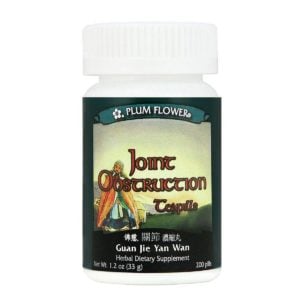 Plum Flower – Joint Obstruction Teapills (Guan Jie Yan Wan)
Plum Flower – Joint Obstruction Teapills (Guan Jie Yan Wan)
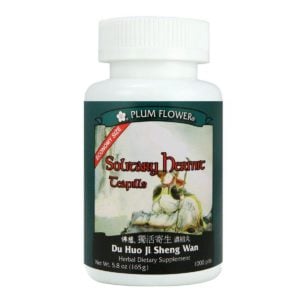 Plum Flower – Solitary Hermit Teapills (Du Huo Ji Sheng Wan)
Plum Flower – Solitary Hermit Teapills (Du Huo Ji Sheng Wan)
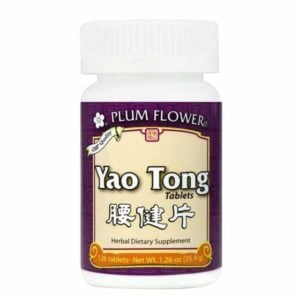 Plum Flower – Yao Tong Pian
Plum Flower – Yao Tong Pian
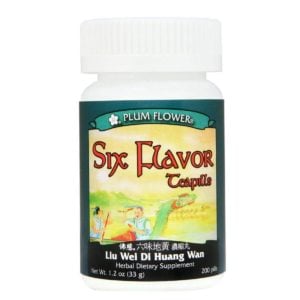 Plum Flower – Six Flavor Rehmannia (Liu Wei Di Huang Wan)
Plum Flower – Six Flavor Rehmannia (Liu Wei Di Huang Wan)
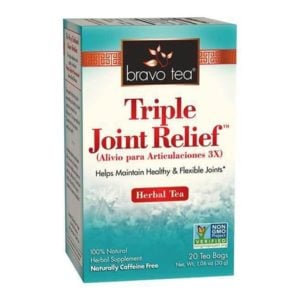 Triple Joint Relief Tea – by Bravo Tea
Triple Joint Relief Tea – by Bravo Tea
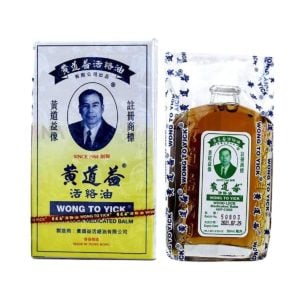 Wood Lock Medicated Oil – Wong To Yick – Huo Luo Oil
Wood Lock Medicated Oil – Wong To Yick – Huo Luo Oil
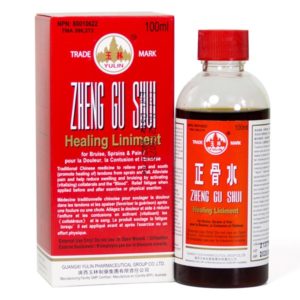 Zheng Gu Shui – Yulin Brand
Zheng Gu Shui – Yulin Brand
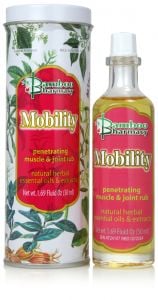 Mobility Muscle and Joint Rub (Ji Rou Guan Jie You) – by Bamboo Pharmacy
Mobility Muscle and Joint Rub (Ji Rou Guan Jie You) – by Bamboo Pharmacy